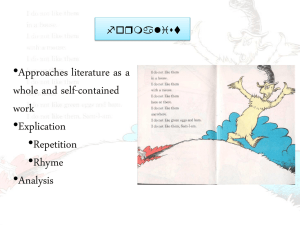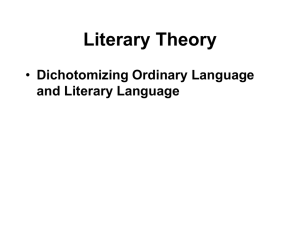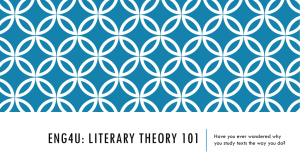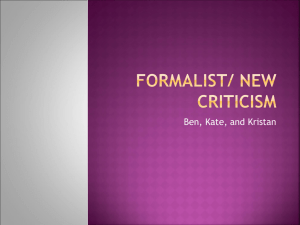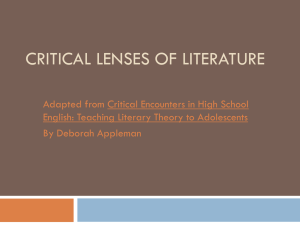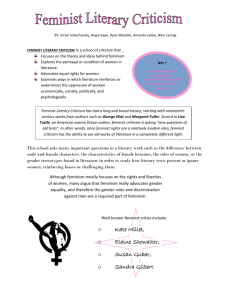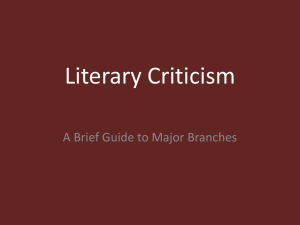Critical/Theoretical Approaches in Modern Literary Theory
advertisement
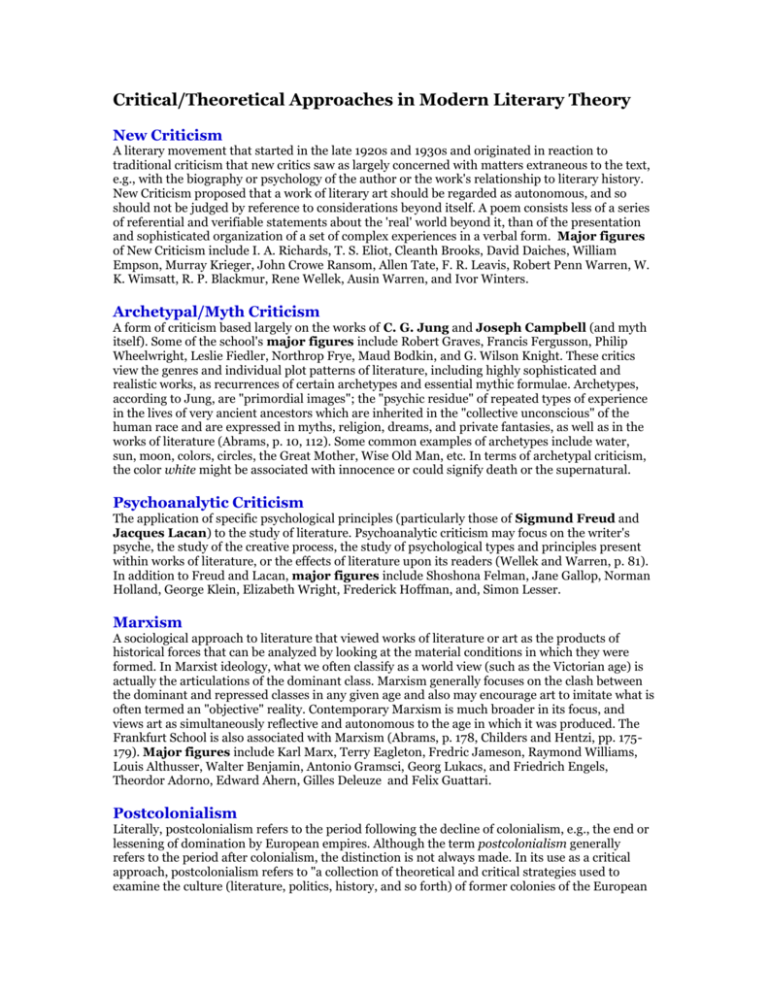
Critical/Theoretical Approaches in Modern Literary Theory New Criticism A literary movement that started in the late 1920s and 1930s and originated in reaction to traditional criticism that new critics saw as largely concerned with matters extraneous to the text, e.g., with the biography or psychology of the author or the work's relationship to literary history. New Criticism proposed that a work of literary art should be regarded as autonomous, and so should not be judged by reference to considerations beyond itself. A poem consists less of a series of referential and verifiable statements about the 'real' world beyond it, than of the presentation and sophisticated organization of a set of complex experiences in a verbal form. Major figures of New Criticism include I. A. Richards, T. S. Eliot, Cleanth Brooks, David Daiches, William Empson, Murray Krieger, John Crowe Ransom, Allen Tate, F. R. Leavis, Robert Penn Warren, W. K. Wimsatt, R. P. Blackmur, Rene Wellek, Ausin Warren, and Ivor Winters. Archetypal/Myth Criticism A form of criticism based largely on the works of C. G. Jung and Joseph Campbell (and myth itself). Some of the school's major figures include Robert Graves, Francis Fergusson, Philip Wheelwright, Leslie Fiedler, Northrop Frye, Maud Bodkin, and G. Wilson Knight. These critics view the genres and individual plot patterns of literature, including highly sophisticated and realistic works, as recurrences of certain archetypes and essential mythic formulae. Archetypes, according to Jung, are "primordial images"; the "psychic residue" of repeated types of experience in the lives of very ancient ancestors which are inherited in the "collective unconscious" of the human race and are expressed in myths, religion, dreams, and private fantasies, as well as in the works of literature (Abrams, p. 10, 112). Some common examples of archetypes include water, sun, moon, colors, circles, the Great Mother, Wise Old Man, etc. In terms of archetypal criticism, the color white might be associated with innocence or could signify death or the supernatural. Psychoanalytic Criticism The application of specific psychological principles (particularly those of Sigmund Freud and Jacques Lacan) to the study of literature. Psychoanalytic criticism may focus on the writer's psyche, the study of the creative process, the study of psychological types and principles present within works of literature, or the effects of literature upon its readers (Wellek and Warren, p. 81). In addition to Freud and Lacan, major figures include Shoshona Felman, Jane Gallop, Norman Holland, George Klein, Elizabeth Wright, Frederick Hoffman, and, Simon Lesser. Marxism A sociological approach to literature that viewed works of literature or art as the products of historical forces that can be analyzed by looking at the material conditions in which they were formed. In Marxist ideology, what we often classify as a world view (such as the Victorian age) is actually the articulations of the dominant class. Marxism generally focuses on the clash between the dominant and repressed classes in any given age and also may encourage art to imitate what is often termed an "objective" reality. Contemporary Marxism is much broader in its focus, and views art as simultaneously reflective and autonomous to the age in which it was produced. The Frankfurt School is also associated with Marxism (Abrams, p. 178, Childers and Hentzi, pp. 175179). Major figures include Karl Marx, Terry Eagleton, Fredric Jameson, Raymond Williams, Louis Althusser, Walter Benjamin, Antonio Gramsci, Georg Lukacs, and Friedrich Engels, Theordor Adorno, Edward Ahern, Gilles Deleuze and Felix Guattari. Postcolonialism Literally, postcolonialism refers to the period following the decline of colonialism, e.g., the end or lessening of domination by European empires. Although the term postcolonialism generally refers to the period after colonialism, the distinction is not always made. In its use as a critical approach, postcolonialism refers to "a collection of theoretical and critical strategies used to examine the culture (literature, politics, history, and so forth) of former colonies of the European empires, and their relation to the rest of the world" (Makaryk 155). Among the many challenges facing postcolonial writers are the attempt both to resurrect their culture and to combat preconceptions about their culture. Edward Said, for example, uses the word Orientalism to describe the discourse about the East constructed by the West. Major figures include Edward Said, Homi Bhabha, Frantz Fanon, Gayatri Spivak, Chinua Achebe , Wole Soyinka, Salman Rushdie, Jamaica Kincaid, and Buchi Emecheta. Existentialism Existentialism is a philosophy (promoted especially by Jean-Paul Sartre and Albert Camus) that views each person as an isolated being who is cast into an alien universe, and conceives the world as possessing no inherent human truth, value, or meaning. A person's life, then, as it moves from the nothingness from which it came toward the nothingness where it must end, defines an existence which is both anguished and absurd (Guerin). In a world without sense, all choices are possible, a situation which Sartre viewed as human beings central dilemma: "Man [woman] is condemned to be free." In contrast to atheist existentialism, Søren Kierkegaard theorized that belief in God (given that we are provided with no proof or assurance) required a conscious choice or "leap of faith." The major figures include Søren Kierkegaard, Friedrich Nietzsche, Martin Heidegger, Jean-Paul Sartre, Albert Camus , Simone de Beauvoir, Martin Buber, Karl Jaspers, and Maurice Merleau-Ponty. Russian Formalism/Prague Linguistic Circle/Linguistic Criticism/Dialogic Theory These linguistic movements began in the 1920s, were suppressed by the Soviets in the 1930s, moved to Czechoslovakia and were continued by members of the Prague Linguistic Circle (including Roman Jakobson, Jan Mukarovsky, and René Wellek). The Prague Linguistic Circle viewed literature as a special class of language, and rested on the assumption that there is a fundamental opposition between literary (or poetical) language and ordinary language. Formalism views the primary function of ordinary language as communicating a message, or information, by references to the world existing outside of language. In contrast, it views literary language as self-focused: its function is not to make extrinsic references, but to draw attention to its own "formal" features--that is, to interrelationships among the linguistic signs themselves. Literature is held to be subject to critical analysis by the sciences of linguistics but also by a type of linguistics different from that adapted to ordinary discourse, because its laws produce the distinctive features of literariness (Abrams, pp. 165-166). An important contribution made by Victor Schklovsky (of the Leningrad group) was to explain how language--through a period of time--tends to become "smooth, unconscious or transparent." In contrast, the work of literature is to defamiliarize language by a process of "making strange." Dialogism refers to a theory, initiated by Mikhail Bakhtin, arguing that in a dialogic work of literature--such as in the writings of Dostoevsky--there is a "polyphonic interplay of various characters' voices ... where no worldview is given superiority over others; neither is that voice which may be identified with the author's necessarily the most engaging or persuasive of all those in the text" (Childers & Hentzi, p. 81). Avant-Garde/Surrealism/Dadaism Avant-Garde literally meant the "most forwardly placed troops." The movement sought to eliminate or at least blur the distinction between art and life often by introducing elements of mass culture. These artists aimed to "make it new" and often represented themselves as alienated from the established order. Avant-garde literature and art challenged societal norms to "shock" the sensibilities of its audience (Childers & Hentzi, p.26 and Abrams, p.110). Surrealism (also associated with the avant-garde and dadaism) was initiated in particular by André Breton, whose 1924 "Manifesto of Surrealism" defined the movement's "adherence to the imagination, dreams, the fantastic, and the irrational." Dada is a nonsense word and the movement, in many ways similar to the trends of avant-garde and surrealism, "emphasized absurdity, reflected a spirit of nihilism, and celebrated the function of chance" (Childers & Hentzi, p. 69). Major figures include André Breton, Georges Bataille, Tristan Tzara, Jean Arp, Richard Huelsenbeck, Francis Picabia, Marcel Duchamp, Man Ray, Raoul Hausmann, Max Ernst and Kurt Schwitters. New Historicism New Historicism (sometimes referred to as Cultural Poetics) emerged in the 1970s and 1980s, largely in reaction to the lingering effects of New Criticism and its ahistorical approach. "New" Historicism's adjectival emphasis highlights its opposition to the old historical-biographical criticism prevalent before the advent of New Criticism. In the earlier historical-biographical criticism, literature was seen as a (mimetic) reflection of the historical world in which it was produced. Further, history was viewed as stable, linear, and recoverable--a narrative of fact. In contrast, New Historicism views history skeptically (historical narrative is inherently subjective), but also more broadly; history includes all of the cultural, social, political, anthropological discourses at work in any given age, and these various "texts" are unranked - any text may yield information valuable in understanding a particular milieu. Rather than forming a backdrop, the many discourses at work at any given time affect both an author and his/her text; both are inescapably part of a social construct. Stephen Greenblatt was an early important figure, and Michel Foucault's intertextual methods focusing especially on issues such as power and knowledge proved very influential. Other major figures include Clifford Geertz, Louis Montrose, Catherine Gallagher, Jonathan Dollimore, and Jerome McCann. Reception and Reader-Response Theory Reader-response theory may be traced initially to theorists such as I. A. Richards (The Principles of Literary Criticism, Practical Criticism and How to Read a Page) or Louise Rosenblatt (Literature as Exploration or The Reader, the Text, the Poem). For Rosenblatt and Richards the idea of a "correct" reading--though difficult to attain--was always the goal of the "educated" reader (armed, of course, with appropriate aesthetic apparatus). For Stanley Fish (Is There a Text in this Class?, Surprised by Sin: The Reader in "Paradise Lost" and Self-Consuming Artifacts: The Experience of the Seventeenth-Century Reader), the reader's ability to understand a text is also subject a reader's particular "interpretive community." To simplify, a reader brings certain assumptions to a text based on the interpretive strategies he/she has learned in a particular interpretive community. For Fish, the interpretive community serves somewhat to "police" readings and thus prohibit outlandish interpretations. In contrast Wolfgang Iser argued that the reading process is always subjective. In The Implied Reader, Iser sees reading as a dialectical process between the reader and text. For Hans-Robert Jauss, however (Toward an Aesthetic of Reception, and Aesthetic Experience and Literary Hermeneutics), a reader's aesthetic experience is always bound by time and historical determinants. Feminism To speak of "Feminism" as a theory is already a reduction. However, in terms of its theory (rather than as its reality as a historical movement in effect for some centuries) feminism might be categorized into three general groups: 1. theories having an essentialist focus (including psychoanalytic and French feminism); 2. theories aimed at defining or establishing a feminist literary canon or theories seeking to 3. re-interpret and re-vision literature (and culture and history and so forth) from a less patriarchal slant (including gynocriticism, liberal feminism); and theories focusing on sexual difference and sexual politics (including gender studies, lesbian studies, cultural feminism, radical feminism, and socialist/materialist feminism). Further, women (and men) needed to consider what it meant to be a woman, to consider how much of what society has often deemed inherently female traits, are culturally and socially constructed. Simone de Beauvoir's study, The Second Sex, though perhaps flawed by Beauvoir's own body politics, nevertheless served as a groundbreaking book of feminism, that questioned the "othering" of women by western philosophy. Early projects in feminist theory included resurrecting women's literature that in many cases had never been considered seriously or had been erased over time (e.g., Charlotte Perkins Gilman was quite prominent in the early 20th century but was virtually unknown until her work was "re-discovered" later in the century). Since the 1960s the writings of many women have been rediscovered, reconsidered, and collected in large anthologies such as The Norton Anthology of Literature by Women. However, merely unearthing women's literature did not ensure its prominence; in order to assess women's writings the number of preconceptions inherent in a literary canon dominated by male beliefs and male writers needed to be re-evaluated. Betty Friedan's The Feminist Mystique (1963), Kate Millet's Sexual Politics (1970), Teresa de Lauretis's Alice Doesn't: Feminism, Semiotics, Cinema (1984), Annette Kolodny's The Lay of the Land (1975), Judith Fetterly's The Resisting Reader (1978), Elaine Showalter's A Literature of Their Own (1977), or Sandra Gilbert and Susan Gubar's The Madwoman in the Attic (1979) are just a handful of the many critiques that questioned cultural, sexual, intellectual, and/or psychological stereotypes about women. Genre Criticism Study of different forms or types of literature. Genre studies often focus on the characteristics, structures, and conventions attributed to different forms of literature, e.g., the novel, short story, poem, drama, film, etc. More recent inquiry in genre criticism centers on the bias often inherent in genre criticism such as its latent (or overt) racism and sexism. Autobiographical Theory As the critical attention to biography waned in the mid-twentieth century, interest in autobiography increased. Autobiography paired well with theories such as structuralism and poststructuralism because autobiography was fertile ground for considering the divide between fact and fiction, challenging the possibility of presenting a life objectively, and examining how the shaping force of language prohibited any simple attempts at truth and reference. Classical autobiographies focused on public figures, were, largely, written by men, and works theorizing autobiography primarily treated men's life writing. Until the mid-1970s, little work was done on theorizing women's autobiographies. Major theorists include Bella Brodski, Paul de Man, Jacques Derrida, Paul John Eakin, Leigh Gilmore, Georges Gusdorf, Carolyn Heilbrun, Philippe Lejeune, Françoise Lionnet, Mary G. Mason, Nancy K. Miller, Shirley Neuman, Felicity Nussbaum, James Olney, Roy Pascal, Adrienne Rich, Sidonie Smith, Patricia Meyer Spacks, Domna Stanton, Julia Watson, and Karl Weintraub. Travel Theory Interest in travel and travel writing has emerged as the result of an intellectual climate that is interrogating imperialism, colonialism, postcolonialism, ethnography, diaspora, multiculturalism, nationalism, identity, visual culture, and map theory. Travel theory's lexicon includes such words as transculturation, metropolitan center, "imperial eyes," contact zones, border crossing, tourist/traveler, imperial frontier, hybridity, margin, expatriation/repatriation, cosmopolitanism/localism, museology, displacement, home/abroad, arrival/return, road narrative, and diaspora, to name just a few. Major theorists include Sara Mills, James Clifford, Anne McClintock, Mary Louise Pratt, Homi Bhabha (bah-bah), Edward Said, Paul Fussell, Steven Clark, Inderpal Grewal, Guy Debord, Umberto Eco, Caren Kaplan, Dean McCannell, James Urry, Jean Baudrillard, and David Spurr. Excerpted from: Siegal, Kristi. “Introduction to Modern Literary Theory.” <http:// http://www.kristisiegel.com/theory.htm> Accessed Feb. 2010.
